Armored car Austro-Daimler Panzerwagen (Austria-Hungary)
Having studied the features of recent military conflicts, specialists from several countries began to consider the possibility of building specialized military equipment. Approximately in 1903-1904, the designer Paul Daimler, the son of Gottlieb Daimler and the head of the Österreichische Daimler Motoren AG (Austro-Daimler) design office, joined such work. He studied the features of recent wars, and also took into account the achievements of industry. As a result of such an analysis, the shape of the future armored car was formed.
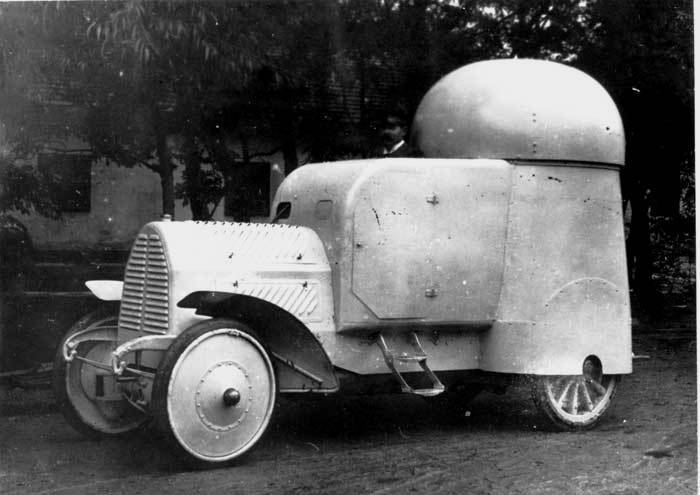
Austro-Daimler Panzerwagen armored car shortly after completion
P. Daimler understood that the future armored car had to work on rough terrain, and this fact made special demands on the chassis. In this case, the car was supposed to protect the crew from possible shelling by the enemy, as well as respond with their machine-gun fire. Taking into account such factors, the chief designer of Österreichische Daimler Motoren and his colleagues formed the technical appearance of the future armored vehicle.
It should be noted that the very first Austro-Hungarian project in the field of armored vehicles was based on a very successful concept. It was proposed to take as a basis the all-wheel drive chassis of the truck and equip it with an armored body with anti-bullet protection corresponding to the existing threats. Armament in the form of one or two machine guns — with the aim of increasing firepower and combat effectiveness — was to be located in a swinging turret. Soon all the positive aspects of this concept were identified, thanks to which it was used in almost all new light armored vehicles projects.
A promising model of a combat vehicle received the simplest name - Austro-Daimler Panzerwagen (“Aistro-Daimler Armored Car”) or abbreviated PzWg. Other designations, as far as is known, were not assigned or used.
From the very beginning of the work it was obvious that the prospective armored car would not have to work too often on good roads, since the battles usually took place on rough terrain. This feature of the hypothetical operation has affected the choice of chassis. P. Daimler took the four-wheel drive four-wheel chassis of a serial truck produced by his company as a basis for the armored car. The relatively high load-bearing capacity of such a product allowed the use of an armored hull of the required design, and all-wheel drive could give the desired off-road mobility.
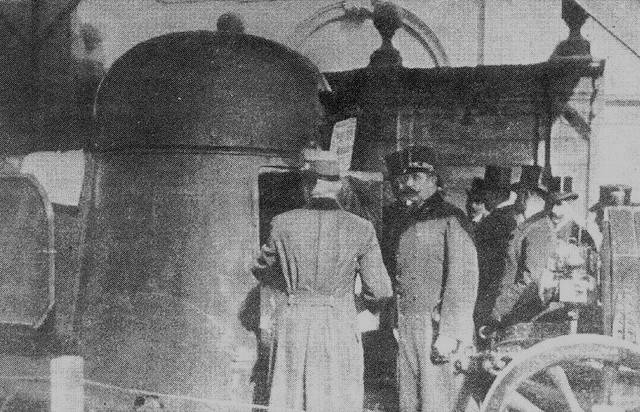
Warlords are studying the armored car
The base truck chassis had a traditional for that time frame design with a front engine, which needed a separate hood. Together with other units of the truck, the armored car received a four-cylinder Daimler gasoline engine with a volume of 4,4 l and a power of 35 hp. The engine was connected with a relatively complex mechanical transmission. With the help of the gearbox, junction box and differentials torque is distributed to all four wheels.
The design of the existing chassis almost unchanged. The armored car had a dependent suspension, the bridges of which were fixed on leaf springs. Openly located front wheels, in order to avoid possible damage by enemy fire, it was proposed to build on the basis of a solid metal disk. The rear ones, in turn, were under the protection of the hull, and therefore they retained the spoke structure.
In connection with the existing technological limitations, the hull was proposed to be assembled from several units using a frame and rivets. A curious feature of it was the rounded edges and large curved details, giving the armored car a recognizable appearance. According to the available data, it was proposed to assemble these or other individual parts into large aggregates, after which the latter could be mounted on the existing chassis. The frontal parts of the body had a thickness of 3,5 mm. Boards and feed were slightly less durable and made of 3-mm steel. The thickness of the armor of the tower was determined in 4 mm.
Chassis units covered several main elements of the body. To protect the engine and gearbox was designed hood, formed by a vertical frontal sheet and a horseshoe-shaped roof. In the frontal part there were blinds for air supply to the radiator, in the sides there were service hatches. The lower part of the engine casing was made integral with the rectangular shields of the frame, which reached the middle part of the body.
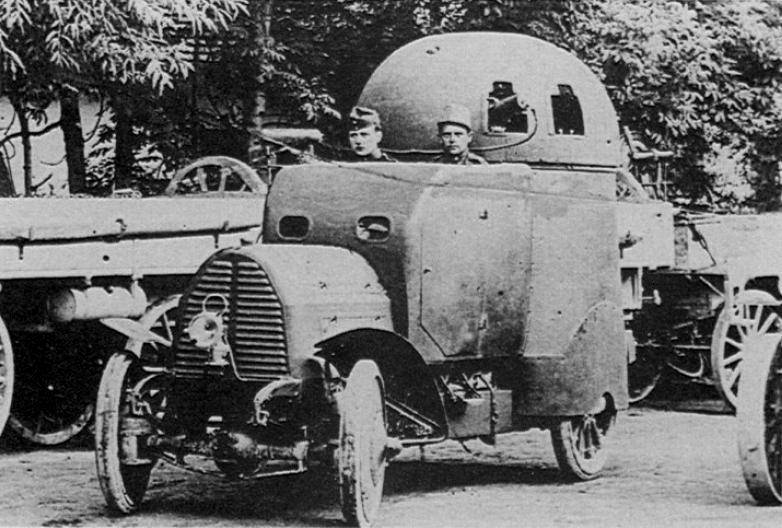
Austro-Daimler PzWg after upgrading
Directly behind the hood was a large compartment that served as a department of management. It had a vertical frontal sheet with a smoothly curved upper part. Provided for the use of vertical sides and horizontal roof. It is curious that all the faces of this aggregate were rounded. A large device was placed in the stern, the shape of which was close to cylindrical. It served as the foundation for the tower.
The armament was planned to be placed in a large swinging turret. For some reason, the latter has received an unusual form. It was suggested to be made in the form of a large and high truncated ellipsoid with a rectangular embrasure in the front. As can be judged, from the inside, one or other parts necessary for mounting on a shoulder strap and ensuring the rotation of the tower around the vertical axis joined the metal dome.
The first version of the armored car Austro-Daimler Panzerwagen had fairly simple weapons. In the only embrasure of the tower it was proposed to install a machine gun. Some sources claim that it was Schwarzlose M.7 caliber 8 mm, which had a water-cooled barrel. At the same time, there are certain grounds for doubts in this version. The armored car, most likely, should have been armed with the Salvator-Dormus M1893 machine gun. Ammunition in the form of several dozen flax or stores was placed inside the combat compartment.
The crew was asked to be two or three people. In front of the habitable compartment were placed the driver and his assistant (or commander). To access their places in the sides of the hull there were large doors. It was suggested to observe the road with the help of the hatches in the roof and in the front plate. On the march, the driver and the assistant could raise their seats on the 305 mm, so they were able to use a large sunroof. In a combat situation, the seats went down, and the road should be monitored through frontal inspection hatches.
The third crew member served as an arrow and was in the fighting compartment. Access to the rear hull volume was provided by the aft door. Search targets and aiming weapons carried out only with a single embrasure. Other means of observation from the gunner were absent.
The Austro-Daimler PzWg armored car was not too large and heavy. The length of the vehicle was 4,1 m, width - 2,1 m, height - 2,7 m. Combat weight - 2,9 t. With the help of the existing engine and all-wheel drive chassis, the armored car could reach speeds of up to 40-45 km / h. It was assumed that he would be able to show good cross-country ability on rough terrain, but the relatively low power density did not allow him to count on high rates.
The development of the first Austro-Hungarian armored car ended in 1905 year. Soon the project documentation was submitted to the command of the armed forces. The generals reacted to the proposed technique without enthusiasm, but still did not refuse it. The company-developer has received an order for the construction of an experimental armored vehicle, which in the near future was planned to be tested and evaluated in the framework of army exercises. In the future, the possibility of ordering a small batch of serial armored cars was not excluded.
The construction of the first Austro-Daimler Panzerwagen prototype was completed in the first months of 1906. After a brief test of the test pilot machine presented to the command. The first demonstration was to be held in the presence of the country's top leadership, including Emperor Franz Joseph I. It should be noted that it was the head of state who ultimately determined the fate of not only the PzWg machine, but also the entire promising direction.
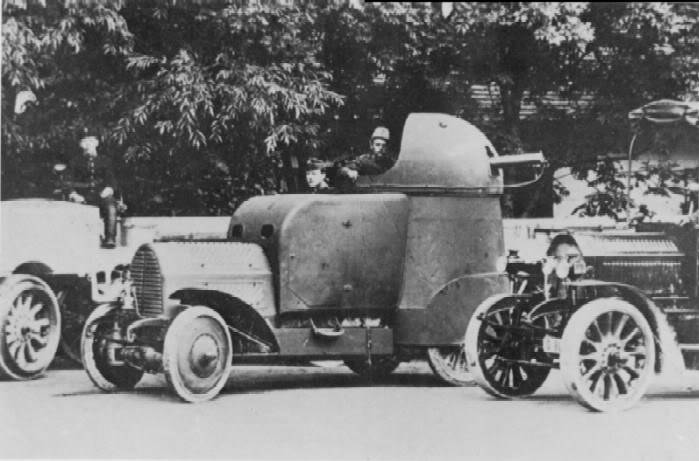
During the demonstration of an armored car there was an embarrassment. The noise of the engine fighting machine scared the horses of command. The unexpected reaction of animals, to put it mildly, upset the emperor. He immediately concluded: such military machines are not needed by the army at the present time, and will not be needed in the future. The generals took this statement as a guide to action. From the existing armored car Austro-Daimler PzWg refused, and in addition, they stopped to consider all this direction in the context of the development of the army. Naturally, about any order for mass production of P. Daimler's armored cars was no longer discussed.
The designers attempted to refine the existing model of military equipment and re-submit it to customers. To improve the main combat and operational characteristics of the existing project, some adjustments were made. Thus, a second embrasure appeared in the tower, and the back of the dome was removed. This led to a reduction in the mass of the turret and simplified observation, and also made it possible to use two machine guns at once with a clear increase in firepower. Another refinement has affected electrical equipment. A headlight appeared in the center of the frontal sheet, which allowed driving an armored car in the dark.
To test new ideas, a new prototype was prepared. According to some data, it was built from scratch, on the other - rebuilt from the existing experienced armored car. Anyway, by the end of 1906, the second version of the Austro-Daimler Panzerwagen with different features and capabilities could be tested. Apparently, due to some problems with the military department, this prototype, as before, carried only one machine gun.
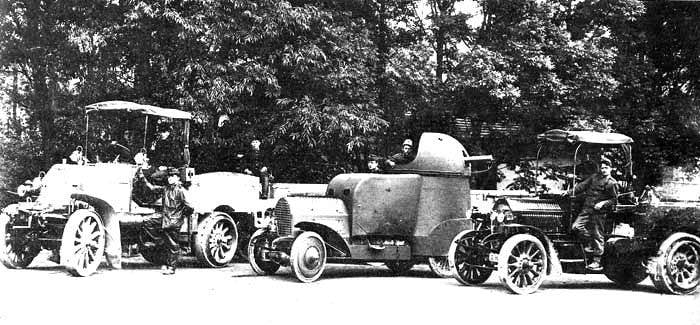
P. Daimler's armored car in a circle of other Austro-Hungarian vehicles
After recent statements by the emperor, the command of the Austro-Hungarian army lost all remnants of its former optimism regarding armored combat vehicles. According to various sources, the new version of the Austro-Daimler PzWg did not even begin to check at the site. The company-developer was immediately refused, and therefore could turn off all the work in the absence of real prospects.
According to some data, Paul Daimler and his colleagues tried to offer their armored car to Kaiser Germany, but this time they failed to interest the potential customer. The German military also showed unjustified conservatism and pushed aside the start of operation of armored vehicles.
An experienced armored car (or armored cars), having lost all prospects, returned to the manufacturer. Most likely, the armored body was soon dismantled, and the chassis returned the original configuration of the truck. Because of this completion of the project, Österreichische Daimler Motoren AG was forced to abandon the design of armored vehicles for many years. A new project of this kind appeared only after the start of the First World War.
It should be noted that the main reason for the unsuccessful completion of the Austro-Daimler Panzerwagen project was not technical problems, but the specific views of the potential operator. The generals of Austria-Hungary with undisguised suspicion of excessively bold developments, and also probably did not want to restructure tactics and strategy of the troops under the use of self-propelled equipment. The final decision in this area was made by Emperor Franz Joseph I - he explicitly stated that the army simply did not need such machines.
Despite the dubious criticism from the command, the armored car Austro-Daimler PzWg could still be of real interest to the army. First of all, its potential was associated with a lack of competition. At that time, there were only a few armored car projects all over the world, and most of them did not reach mass production with subsequent operation. Thus, only a few machines designed by P. Daimler could seriously increase the potential of the Austro-Hungarian army.
Remarkable is the fact that the designers of the Austro-Daimler company, without having any experience in creating armored cars, were able to form and use the optimal look of a combat vehicle in their very first project of this kind. Their PzWg was built on the all-wheel drive truck chassis and had an armored hull divided into several compartments. Rear equipped with a rotary turret with the installation for machine-gun armament. In the future, this concept has managed to gain popularity and in fact became the standard for armored vehicles.
However, not always successful solutions lead to the desired results. Not bad from a technical point of view, the project armored car Austro-Daimler Panzerwagen faced a problem in the form of conservatism and mistrust on the part of the command. In the future, this led to serious problems: in the First World War, Austria-Hungary had to enter without any armored vehicles and make up for lost time during the battles.
Based on:
http://tanks-encyclopedia.com/
http://aviarmor.net/
http://landships.info/
http://landships.activeboard.com/
Oswald V. Complete catalog of military vehicles and tanks Germany 1900-1982 M .: AST, Astrel. 2003.
- Ryabov Kirill
- Landships.info, Aviarmor.net
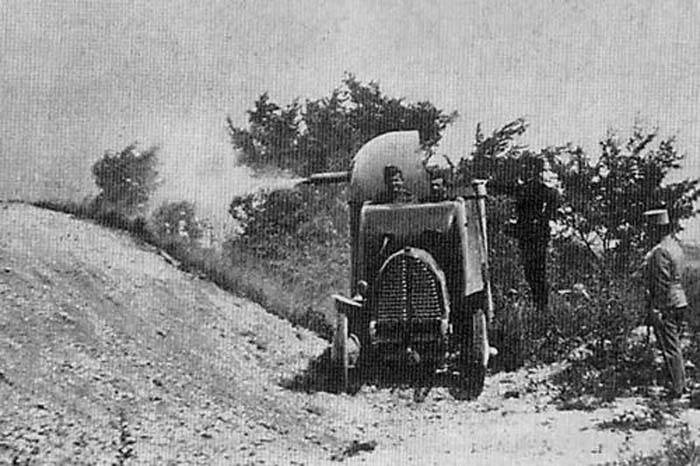
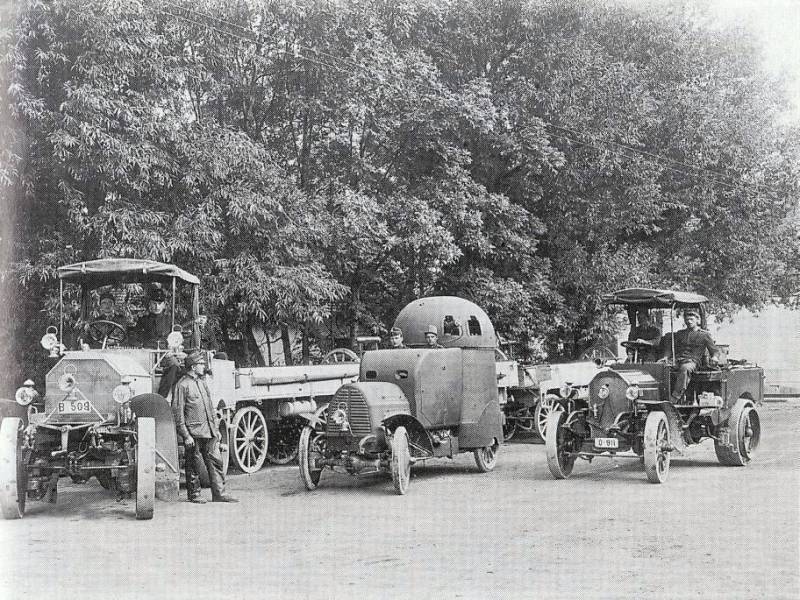
Information